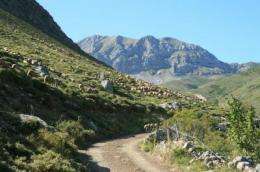Transhumance helps vulture conservation

Researchers from the University of Segovia and the University of León have shown for the first time the close space-time relationship between the presence of the griffon vulture and transhumant sheep farming in mountain passes. Transhumance has fallen in some parts of Spain by up to 80% over the past four years. The scientists say that traditional livestock farming practices are crucial for the preservation of mountain ecosystems.
European health regulations designed to control Bovine Spongiform Encephalopathy (BSE), or Mad Cow Disease, requires all cattle carcasses to be removed from fields, which has led to a significant scarcity of food for carrion birds in Spain, with various impacts on their conservation.
"However, in mountain areas with widespread livestock, it is impracticable to remove cattle carcasses. This is the case with transhumant farms during the periods that flocks spend in summer fields, a traditional practice that also provides an important trophic resource for vultures in the modern world", Pedro P. Olea, a researcher at the Business Institute of the University of Segovia, and Patricia Mateo-Tomás, a researcher at the University of León, tell SINC. This is the conclusion of a study they have recently had published in the journal Biological Conservation.
"Food resulting from transhumant farming activities in the Cantabrian mountain range could maintain up to 750 vultures over the period of almost six months that transhumant livestock graze the mountain passes", say the scientists.
The scientists focused on the upper part of the trophic chain, and linked transhumance to presence of the griffon vulture (Gyps fulvus), "a relationship that had not previously been studied in depth", they say.
The Cantabrian mountain chain, an exceptional case
The study, which includes data from 1989 up until the present day, contains 85 interviews with shepherds, and describes griffon vulture behaviour as follows: "They choose summer resting places in mountain passes most used by sheep, and respond quickly to any changes in the use of these passes by livestock". However, the biologists report that the number of vultures is more dependent on the number of head of cattle, given the large amount of food that each dead cow provides.
The presence of these summer resting spots, sometimes more than 12 km from the places where the vultures raise their young, is linked "to the presence of a predictable source of food because, despite the health regulations requiring dead cattle to be removed from fields, the terrain in these mountain passes means that 90% are left to the vultures", explain the researchers.
According to the scientists, the presence of transhumant cattle in the Cantabrian mountain range gives them between 1.5 and six times more food than that available to them from local livestock. "This livestock farming practice not only constitutes an important trophic resource for the griffon vulture, but possibly also for other occasional scavengers, such as the brown bear and the wolf", say Olea and Mateo-Tomás.
Transhumance was the foundation of the wool-based Spanish economy for centuries. The Cantabrian mountain range is one of its final strongholds. Up to 80% of the mountain passes traditionally occupied by transhumant livestock during the summer are now no longer in use. In addition, "there has been an 80% decline in the number of head of sheep over the past four years", say the biologists.
More information: Olea, Pedro P.; Mateo-Tomás, Patricia. "The role of traditional farming practices in ecosystem conservation: The case of transhumance and vultures" Biological Conservation 142(8): 1844-1853, Aug 2009.
Source: FECYT - Spanish Foundation for Science and Technology
















